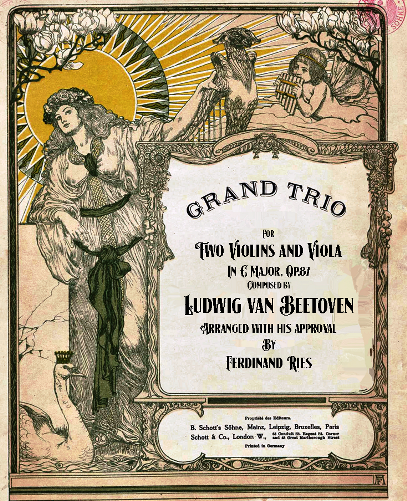Presents
Ludwig van Beethoven
Trio for 2 Violins and Viola in C Major, Op.87
Arranged with Beethoven's Approval by Ferdinand Ries from the Trio for 2 Oboes & English Horn

Beethovenís Trio in C Major, Op. 87 was composed in 1795 and was originally for the unusual combination of 2 Oboes and English Horn. Without doubt, this is a very unusual combination and Beethoven was unable to get a publisher to print the music not only because he had just arrived in Vienna and was a virtual unknown also because of the unusual combination which most likely had been intened for the famous wind ensemble belonging to the Elector of Bonn where Beethoven had speant his youth. Eleven years were to pass before Beethoven was able to get a publisher to bring out the work and this probably because by 1806 he was famous and his music was selling like hot cakes. Nonetheless, the Vienna publisher Artaria, who agreed to print the trio, must have known that sales for a work of this combination, even by a Beethoven, were going to be very limited. As a result, Artaria insisted that an arrangement for 2 violins and viola be made. Beethoven either did not have the time or the to make such an arrangement. For a long time it was not known who eventually made the arrangement, but scholars now believe it was his student and friend, the composer Ferdinand Ries. Ries, at Beethovenís direct made many arrangements for him. It is definitely known that Beethoven approved the arrangement which Artaria published.
The arrangement made by Ries, perhaps at the request of Dominic Artaria, is though strong enough for concert performance ideally suited to skilled amateurs, obviously what was then the target consumer. While not particularly difficult, it is melodic and agreeable and demands idiomatic playing and a good sense of ensemble from all three players. It is in the four-movement classical form yet it preserves the pleasing character of the serenade music Mozart and others wrote for lighter occasions over the final decades of the 18th century. It has an engaging Allegro for its first movement, filled appealing themes. It is followed by a a lyrical Adagio and then a spirited Menuetto, which is closer to a scherzo than a minuet. The finale starts off quiently but gradually grows more animated, and soon the music is flying along on triplet runs which brings the work to a satisfying conclusion.
Parts: $14.95